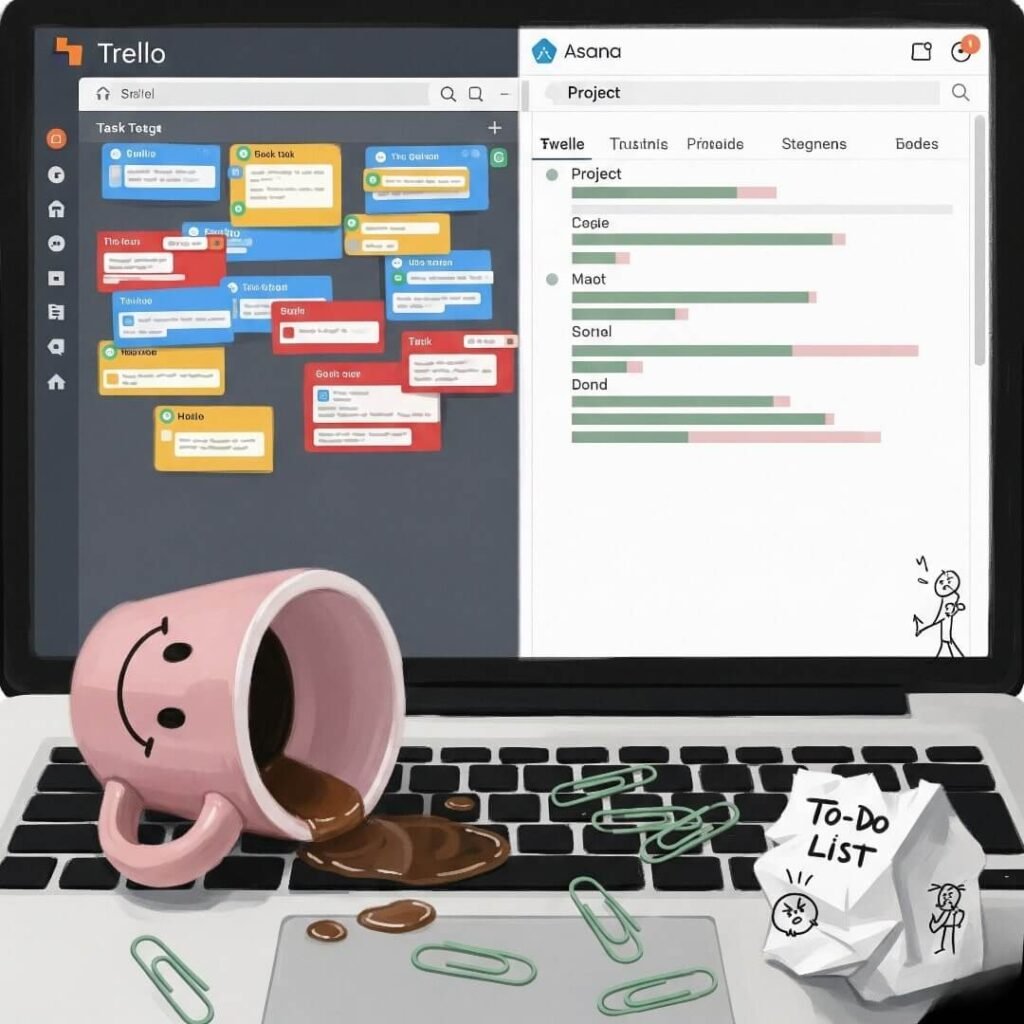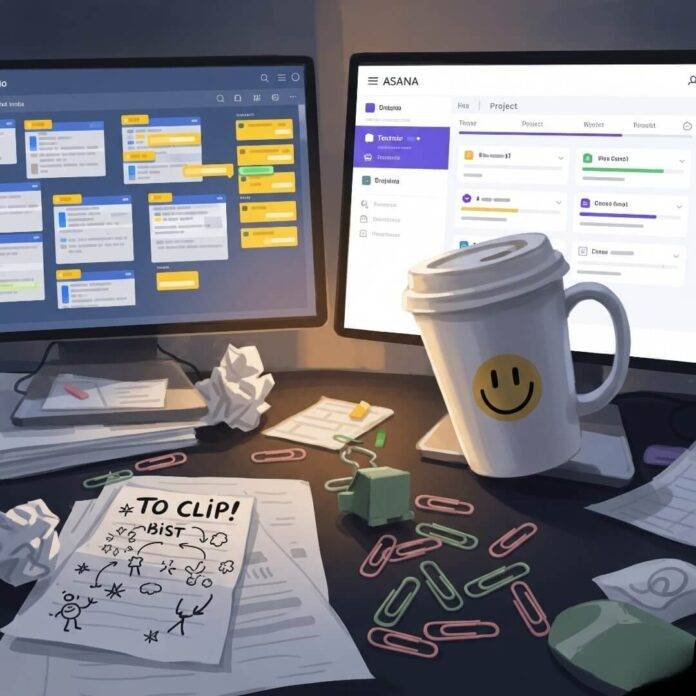Trello vs Asana, oh man, where do I even start? I’m sitting in my tiny Brooklyn apartment, fan buzzing like it’s tryna start a band, and my desk’s a disaster—old coffee cups, a random pen cap, and my cat’s hair everywhere. I’m no productivity queen, just a freelancer tryna not lose my mind juggling clients and, like, remembering to buy toothpaste. I’ve been wrestling with Trello and Asana for months, and let me tell you, it’s been a wild ride—think me, spilling coffee, cursing at my laptop, and maybe crying once. Here’s my raw, kinda messy take on Trello vs Asana, straight from my chaotic life in the US, with all the screw-ups and “aha” moments.
Why I Needed Trello vs Asana, Like, Yesterday
Picture this: I’m balancing three writing gigs, a side hustle selling thrifted jackets, and a promise to my roommate to stop leaving dishes in the sink. My brain’s like, “Girl, you’re on your own.” Sticky notes were my go-to, but half of ‘em ended up stuck to my socks. I heard about Trello and Asana from a friend at a dive bar in Greenpoint, over greasy fries and a jukebox blaring Springsteen. She said they’d save my soul. Spoiler: They helped, but I still managed to mess it up spectacularly.
Trello: My Bright, Messy BFF
Trello’s like that pal who’s always down for chaos but never judges. You open it, and it’s these colorful boards, cards you can drag around—like a Pinterest board for your to-do list. I set up boards for my writing jobs, one for my jacket hustle, even one for “Life Crap” ‘cause I kept forgetting to call my landlord about the leaky faucet. It was so satisfying, like organizing my brain while eating leftover lo mein. But then I went nuts. I made, like, a dozen boards, and suddenly I’m lost in a sea of cards, wondering where my client deadline went. Oh, and that time I dragged “Buy cat litter” into “Client Proposals”? My cat was happy, my client was not. Big oof.

Asana: When I Tried to Be Fancy
Then there’s Asana, the tool that makes me feel like I should be in a suit, not my stained sweatshirt. I ditched Trello for Asana when my boards started looking like my junk drawer. Asana’s all sleek, with timelines and tasks that scream, “Get it together!” I set up a project for a big client, added due dates, subtasks, the whole deal. Felt like a legit boss for, like, a hot minute. Then I realized I spent two hours organizing tasks instead of actually working. Like, I’m eating cold pizza, my cat’s knocking over my water glass, and Asana’s asking me to set “dependencies.” Dude, I’m dependent on my bodega guy for coffee, that’s it.
Asana’s Pros and Cons, From My Couch
Here’s the deal with Asana, no filter:
- Pros: It’s awesome for teams or big projects. I used it with some freelancers for a campaign, and it kept us from ghosting each other. The timeline view’s dope (check Asana’s timeline guide).
- Cons: It’s overkill for solo folks. I felt like I was planning a NASA launch. Also, the free version’s super limited—want the good stuff? Gotta pay up.

Trello vs Asana: My Chaotic Showdown
Okay, Trello vs Asana, let’s do this. I’m sipping bodega coffee, tryna not spill it on my keyboard (again), and here’s how these tools stack up in my messy world.
Ease of Use: Trello’s Easy, Asana’s a Project
Trello’s so simple, I set it up while half-watching Love Island. Drag, drop, boom—done. Asana’s like signing up for a masterclass in organization. I spent an hour watching tutorials (like this one from Asana) just to get the timeline thing. If you’re a visual disaster like me, Trello’s your vibe. If you don’t mind a learning curve, Asana’s got structure for days.
Solo vs Team: Trello’s Chill, Asana’s Bossy
I used Trello with a couple friends for my jacket biz, and it was fine—everyone could add cards, comment, no drama. Asana, though? It’s made for teams. I used it with a client’s marketing crew, and the task-assigning, progress-tracking stuff was legit (see Asana’s team tips). But for solo work, Asana’s like using a tank to swat a fly. Trello’s better for loners like me who just need to not lose their grocery list.
Features: Free vs Paid, What’s Up?
Trello’s free version is super chill—unlimited boards, cards, and up to 10 team members. I used it for ages without spending a cent. Asana’s free plan? It’s like a free sample at the grocery store—teases you, then you gotta pay for the real deal, like timelines or fancy reports. I hit the free limit mid-project and was so annoyed. Wanna check? Look at Trello’s pricing or Asana’s pricing.

My Epic Fails and What I Figured Out
I’ve screwed up with both, trust me. With Trello, I went ham and made too many boards, like I was hoarding digital Post-its. My client deadline got lost under “Cat Vet Appt.” Tip: Keep it simple, maybe one board per gig. With Asana, I got sucked into over-planning. I spent a whole afternoon sorting tasks for a blog post instead of writing it. Also, I tried updating Trello on a packed subway and accidentally archived a board. Cue me freaking out at 2 a.m., eating cereal straight from the box.
Which One’s for You? My Hot Mess Take
Here’s where I’m at, typing this while my cat glares at me for stealing her spot on the couch. If you’re a chaotic solo act like me, tryna keep your life from imploding, Trello’s your guy. It’s fun, colorful, and doesn’t care if you forgot what month it is. But if you’re running a team or tackling a big project with lots of pieces, Asana’s structure will save your butt. It’s like picking between a dive bar with $5 beers (Trello) or a fancy lounge with $15 cocktails (Asana). Both slap, just depends on your mood.
Wrapping Up This Trello vs Asana Rant
So, Trello vs Asana? I’ve spilled my coffee, my guts, and probably my dignity figuring this out. Both tools have kept me from totally losing it, but they’ve also made me wanna yeet my laptop into the Hudson. Try ‘em both—free plans mean you can mess around without dropping cash. Hit me up in the comments or on X (like these folks arguing about tools) and tell WHICH one you vibe with. Now, I gotta go deal with this cat hair situation before my roommate flips.
Outbound links :















































